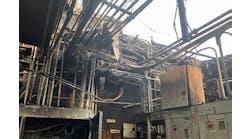Hybrid twins yield quick and accurate results
“With the hybrid architecture, the physics model and simulation data, along with sensor data, feed a model-based decision-support system that drives improved process yield, performance and predictability.” Ansys’ Prith Banerjee explained the evolving technologies that promise to more than quintuple the digital-twin market over the next five years.
The current digital twin market is estimated at about $4 billion annually, and, by 2025, it is expected to expand to $26 billion, said Prith Banerjee, chief technology officer at Ansys. He discussed the challenges and opportunities in this expanding market during his Digital Strategists keynote presentation at this week’s Automation Fair At Home event, presented by Rockwell Automation.
Digital twins based on data analytics require immense amounts of data for accuracy, and, while physics-based simulation models are highly accurate, they take an incredible amount of time to run. New hybrid systems are combining the best of both worlds, for a digital twin that is both quick and exact.
“Many confuse digital twins with a model of a physical asset,” Banerjee said. A digital twin must have three primary elements: a physical asset; a model of the physical asset in a virtual space; and a link for data to flow from the real space to the virtual.
“You have to have all three things to make a digital twin,” he said. “I have an asset. I put some sensors on the asset. I have a model of the asset, and I have a two-way information flow, based on an IoT platform. This is how digital twins work.” The value of digital twins allows industry to increase revenue by providing new businesses, such as energy or mobility as a service. Digital twins also provide value in reducing downtime and its significant costs. “Digital twins help with both the top line and the bottom line,” Banerjee said.
The early work on digital twins was in the aerospace industry to help with preventive maintenance on jet engines. “In the aircraft industry, people have used models of their aircraft engines, tied with operational data pulled in from the actual flight path, to try to drive better predictive analytics for operations maintenance,” Banerjee said. Digital twins have also been used in the automotive, manufacturing, buildings and infrastructure, and oil and gas industries. In manufacturing, digital twins are used to drive operational equipment efficiency (OEE). “Typically, at the manufacturing plant, the OEE may be 60%. Through the use of digital twins, you can raise that up to maybe 80%, and that transfers to real productivity improvement,” Banerjee said.
Digital twins are also used in different phases of a connected operation to design, operate and maintain an asset. When building an asset, a digital twin can act as a design. Once the asset moves into operation, a digital twin models smart production. Finally, as the asset is maintained, a digital twin acts to anticipate maintenance. Of the expanding digital twin market projected to reach $26 billion by 2025, two-thirds is estimated to focus on assets’ operational phase. About $5.8 billion is estimated for the design phase, and about $2 billion for the analysis and maintenance phase. Today, about 25% of the digital twin industry is focused on manufacturing. By 2025, that number is expected to drop to 15%, as the digital twin market takes off in the automotive and transportation sectors.
Data driven vs. physics-based
Currently, the majority of industries use data-driven models as the basis for their digital twins, Banerjee said. Data is collected on an asset through sensors, which are connected to an IoT platform and collect data under normal conditions. Typically, before failure, equipment will give a signal of some kind; data from the sensor changes, and then the neural network models tag it as an abnormal condition. “The advantage of the data-driven approach is you don’t have to know the physics of the asset,” Banerjee said. “The disadvantage is you need lots of training data to build a data-driven model, and your neural network is only trained on the situations you have seen.”
This is what motivates the need for physics-based modeling, where “you physically simulate how an asset could fail in the real world,” he said. When combined with the real-time data, this modeling can become even more accurate, by continually adjusting the model to match the true conditions. “You have a model, and you have two-way information flow between the physical asset and the model, and you make the model much more accurate. This is what makes physics-based digital twins super-accurate,” Banerjee said.
Last year Ansys created its first twin-builder tool using reduced-order models (ROMs), which run much faster than 3D models. Ansys’ newest phase of the twin-builder has a hybrid digital twin architecture, combining data-driven analytics with ROM simulations. “What we have just done this year is to take the data-based analytics with the physics-based approach and come up with a really interesting solution,” Banerjee said.
The next phase of the twin-builder model uses ROMs to simulate extensive 3D modeling, but uses real-time asset performance data from an IoT platform to tweak the results. “This hybrid model is what we now have,” Banerjee said. “It produces really highly accurate results, and it’s very fast.” With the hybrid architecture, the physics model and simulation data, along with sensor data, feed a model-based decision-support system that drives improved process yield, performance and predictability for industrial operators.
“So, what we have done is taken this combined physics and hybrid model and used it to drive high-value applications, like predictive maintenance,” Banerjee said. Other high-value applications include performance monitoring (identifying inefficient operating conditions); anomaly detection (identifying unexpected behavior and operation); and diagnostics (identifying and pinpointing root cause in a large system).
Partnerships for ecosystem solution
Building digital twins in different phases in many different industries is not something Ansys can do alone, Banerjee said, noting many of the company’s important partners involved in open ecosystem solutions. Ansys has partnered with many organizations such as Rockwell Automation, PTC, SAP, Microsoft Azure and more to bring combined solutions to customers.
Ansys is also involved with the Digital Twin Consortium. It is one of seven founding members of the 150-member organization that is building different use cases in different verticals, such as manufacturing, aerospace and defense, oil and gas, and automotive.
“We’re also working with Microsoft on Digital Twin Definition Language (DTDL),” Banerjee added. “When you have a large system like an airplane, it has a fuselage and two wings, and you can build a model of the plane based on the fact that you have a subsystem of two wings and a fuselage. Then, you double-click on the wing, and it says the wing has two engines. You double-click on the engine, and it says the engine has 52 blades. You double-click on the blade, and you have a model of that. So essentially, you can build a whole system-level model of the large system, and it can build it out of subcomponents, so you can have a digital twin of the whole system, of the subsystem and the sub-subsystems and so on,” Banerjee said.
Customers that have already used this digital twin technology include Volkswagen, which used it to build a speed-record-breaking electric-powered sports car. Verbund Hydro makes large water turbines and uses the technology to predict the wear of turbines under different loading conditions. And Kaeser Compressor builds digital twin models of its compressors to quickly demonstrate different scenarios for potential customers.
The editors of Control, Control Design and Smart Industry are providing coverage of Automation Fair At Home, bringing you breaking news, innovations and insights from the virtual event. Once Automation Fair At Home is over, the editors will put together an event report featuring the top news. Pre-order your copy today.






